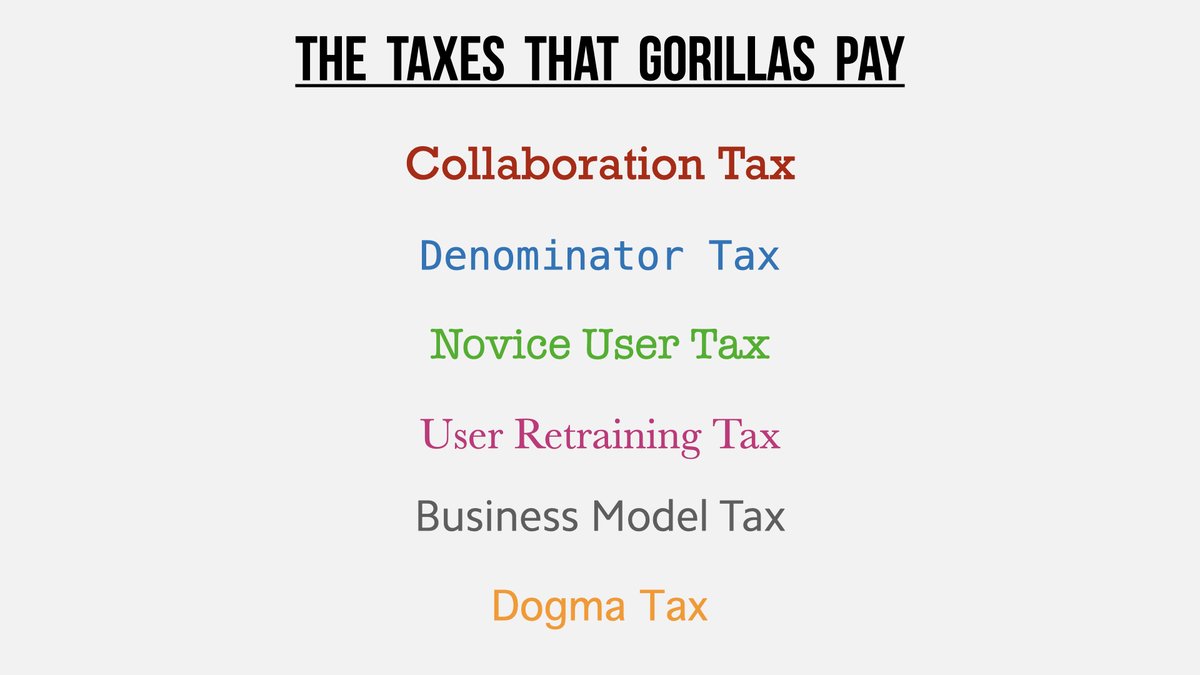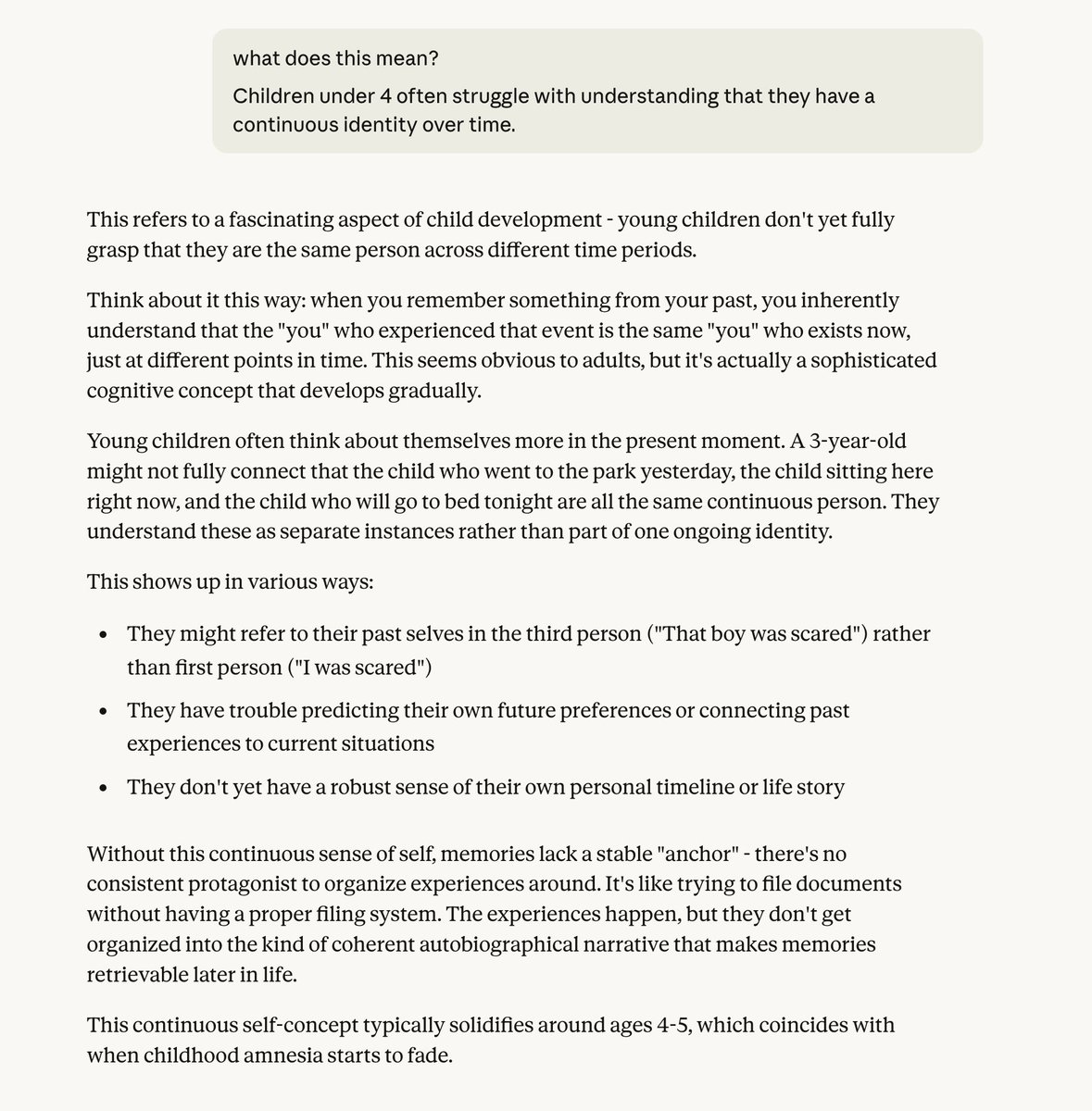If you’re a Startup trying to compete with a Megacorp—the 800-pound Gorilla in the space—you need to understand the tax inherent to being a Gorilla
And then you need to make that tax work against the Gorilla—with your product's positioning & features
A thread on Gorilla taxes👇🏾
And then you need to make that tax work against the Gorilla—with your product's positioning & features
A thread on Gorilla taxes👇🏾

1/
Collaboration Tax
Getting two or more product groups at a megacorp to collaborate on creating a seamless end user experience is the hardest problem in computer science.
(I am not joking)
Collaboration Tax
Getting two or more product groups at a megacorp to collaborate on creating a seamless end user experience is the hardest problem in computer science.
(I am not joking)
Examples of Collaboration Tax:
Calendly exists because the Gmail team & Calendar team haven’t worked together on creating a more seamless experience for that use case.
Loom might succeed because the Gmail, Video, Meet teams at Google are probably too busy with their own goals.
Calendly exists because the Gmail team & Calendar team haven’t worked together on creating a more seamless experience for that use case.
Loom might succeed because the Gmail, Video, Meet teams at Google are probably too busy with their own goals.
The takeaway for startups:
If you can create meaningful value by seamlessly integrating features of two or more distinct Gorilla products, you will typically have a lot of runway before the Gorilla can get its act together and eliminate its Collaboration Tax.
If you can create meaningful value by seamlessly integrating features of two or more distinct Gorilla products, you will typically have a lot of runway before the Gorilla can get its act together and eliminate its Collaboration Tax.
2/
Denominator Tax
Once a Gorilla’s product reaches massive scale (i.e. the denominator for its metrics gets very large), the pressure of OKRs & incentives will often force the Gorilla’s product teams to prioritize breadth of usage more than depth of usage.
Denominator Tax
Once a Gorilla’s product reaches massive scale (i.e. the denominator for its metrics gets very large), the pressure of OKRs & incentives will often force the Gorilla’s product teams to prioritize breadth of usage more than depth of usage.
Examples of Denominator Tax:
Google Docs, which needs to work across a tremendous breadth (basically everyone) vs. Dropbox Paper, great for engineers & product people
Coda/Notion/etc. benefit from both the Denominator Tax (more focused) & the Collaboration Tax (more integrated)
Google Docs, which needs to work across a tremendous breadth (basically everyone) vs. Dropbox Paper, great for engineers & product people
Coda/Notion/etc. benefit from both the Denominator Tax (more focused) & the Collaboration Tax (more integrated)
The takeaway for startups:
Attack the Gorilla’s product by first tackling high-value verticals or use cases that won't meaningfully move the Gorilla’s “raw numbers”. The Gorilla won’t attack back even if it is well aware of your existence (and is losing some business to you).
Attack the Gorilla’s product by first tackling high-value verticals or use cases that won't meaningfully move the Gorilla’s “raw numbers”. The Gorilla won’t attack back even if it is well aware of your existence (and is losing some business to you).
3/
Novice User Tax
A Gorilla has a lot to lose if its products appear to create friction for its novice users. The friction might be pricing, a steeper learning curve, seeing advanced features, etc. That's why a Gorilla’s products are typically quite suboptimal for power users.
Novice User Tax
A Gorilla has a lot to lose if its products appear to create friction for its novice users. The friction might be pricing, a steeper learning curve, seeing advanced features, etc. That's why a Gorilla’s products are typically quite suboptimal for power users.
An example of Novice User Tax:
There’s a high demand for Superhuman because Gmail doesn’t offer an interface that’s optimized for power users of email.
(Note how Gmail itself launched & grew as an email service for power users vs. the leading email services at the time)
There’s a high demand for Superhuman because Gmail doesn’t offer an interface that’s optimized for power users of email.
(Note how Gmail itself launched & grew as an email service for power users vs. the leading email services at the time)
The takeaway:
Consider positioning your product as a power user alternative to an existing Gorilla product.
This has two distinct benefits
1) Association: users will easily grok what your product does
2) Differentiation: your target users will readily try & promote your product
Consider positioning your product as a power user alternative to an existing Gorilla product.
This has two distinct benefits
1) Association: users will easily grok what your product does
2) Differentiation: your target users will readily try & promote your product
~BONUS~
The User Retraining Tax, a corollary to the Novice User Tax:
Getting a Gorilla to significantly revamp its UI is the second hardest problem in computer science.
The massive user backlash from UI revamps ensures that the revamp happens too slowly, too late, or never.
The User Retraining Tax, a corollary to the Novice User Tax:
Getting a Gorilla to significantly revamp its UI is the second hardest problem in computer science.
The massive user backlash from UI revamps ensures that the revamp happens too slowly, too late, or never.
4/
Business Model Tax
A Gorilla will often find it hard to change or augment its business model or pricing model with an entirely new one, especially if its current model provides high margins and scale.
Business Model Tax
A Gorilla will often find it hard to change or augment its business model or pricing model with an entirely new one, especially if its current model provides high margins and scale.
An example of Business Model Tax:
Twitter primarily has an advertising business model (with high margins & scale), so it will find it difficult to adopt an additional business model that helps its creators monetize natively within Twitter.
Enter Substack, Patreon, etc.
Twitter primarily has an advertising business model (with high margins & scale), so it will find it difficult to adopt an additional business model that helps its creators monetize natively within Twitter.
Enter Substack, Patreon, etc.
5/
Dogma Tax
A Gorilla will convert a belief—which may have been valid at a certain point—into long-lasting dogma whose validity fades with time.
Examples:
Google Hangouts (everything in the browser) vs. Zoom
Microsoft (mobile is for serious business) vs. iPhone/Android
Dogma Tax
A Gorilla will convert a belief—which may have been valid at a certain point—into long-lasting dogma whose validity fades with time.
Examples:
Google Hangouts (everything in the browser) vs. Zoom
Microsoft (mobile is for serious business) vs. iPhone/Android
While these are the main ones, Gorillas face other such taxes e.g. PR tax, Regulatory tax, Infra tax, Bundling tax
That’s why strategy isn’t just a big company thing
Shrewd strategy is vital for Startups competing against Gorillas
Strategy+Speed➜Success
All the best to you👍🏾
That’s why strategy isn’t just a big company thing
Shrewd strategy is vital for Startups competing against Gorillas
Strategy+Speed➜Success
All the best to you👍🏾
Back to the top of this thread:
https://twitter.com/shreyas/status/1332065861813694465
Footnote:
While this thread is addressed to Startups, it's equally relevant for the people working at Gorillas, in 2 ways:
1) You can use the vocabulary here to name & tame your org's taxes
2) If you're competing against another Gorilla, play against its taxes just like a Startup
While this thread is addressed to Startups, it's equally relevant for the people working at Gorillas, in 2 ways:
1) You can use the vocabulary here to name & tame your org's taxes
2) If you're competing against another Gorilla, play against its taxes just like a Startup
Some of the points in this thread are related to Counter-positioning, my favorite of Helmer's 7 strategic powers:
"A newcomer adopts a new, superior business model which the incumbent does not mimic due to anticipated damage to their existing business."
amazon.com/7-Powers-Found…
"A newcomer adopts a new, superior business model which the incumbent does not mimic due to anticipated damage to their existing business."
amazon.com/7-Powers-Found…
If you liked this thread, you might also like some of this👇🏾
https://twitter.com/shreyas/status/1303150374124048386
Also check out this thread on product strategy
https://twitter.com/shreyas/status/1262072050815954944
At some point, a Gorilla becomes its own biggest customer. This means that, despite its various advantages, it cannot be as much in synch with its real customers' needs as you can be as a Startup.
You are left-of-𝑥, Gorilla is right-of-𝑥. The framework:
You are left-of-𝑥, Gorilla is right-of-𝑥. The framework:
https://twitter.com/shreyas/status/1332889514079965186
• • •
Missing some Tweet in this thread? You can try to
force a refresh














